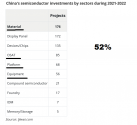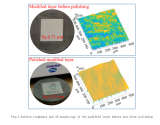The Chinese are exercising their legs, geopolitics is making that 52% of the investment in China is going to upstream part of the supply chain of their semiconductor industry.

Affected by geopolitical factors coupled with the downturn of the chip market business cycle, China's semiconductor industry development focus is gradually shifting upstream. During 2021-2022, there were 176 semiconductor materials projects and 56 equipment projects, they took up a combined share of more than 30% of the 742 projects in total.
In comparison, during 2016-2020, there were only 40 semiconductor material projects and 7 equipment projects, accounting for a total of 15.6%.
In other words, the Chinese invested in a single year in the most neglected foreign dominated area of their semiconductor industry DOUBLE of what they invested in four years.

Affected by geopolitical factors coupled with the downturn of the chip market business cycle, China's semiconductor industry development focus is gradually shifting upstream. During 2021-2022, there were 176 semiconductor materials projects and 56 equipment projects, they took up a combined share of more than 30% of the 742 projects in total.
In comparison, during 2016-2020, there were only 40 semiconductor material projects and 7 equipment projects, accounting for a total of 15.6%.
In other words, the Chinese invested in a single year in the most neglected foreign dominated area of their semiconductor industry DOUBLE of what they invested in four years.

